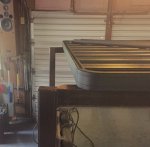Rather than just thinking about how to bolt your system down, maybe look at the whole package. We did a couple sled tests (simulated crash tests) as well as a crash analysis many years ago. We were fortunate to have one of the US vehicle manufacturers put our tents on some vehicles they were crash testing. This was on the "universal" mount system that virtually all the roof tent manufactures have adopted. I was surprised by the results, the tents and bar system passed but all had slid about two inches because of the collision force. In the case of an actual collision, a rear ender, the tent slid back about two inches on the mounts.
I know you are designing a very different system but you may wish to factor in the forces in a collision. In the case of our crash analysis, it was a crash that our field tester, a good friend of mine was involved in. Unfortunately, there isn't a lot of information to go on as there are no tests to my knowledge above 165 pounds. Most of the roof bar mounting systems are only tested that high so this would be the weak link. In fact some of the bar feet are made of high strength plastic.
It sounds like your equipment is very capable but you still might want to inspect all the mount points. Vehicle manufacturers don't give out a lot of information on the strength of their mounts. Even the rack manufacturers don't always know. We had downrated a very popular SUV to our tents 125 poundss or less. I was at SEMA and talked to the OEM rack manufacturer. They correctly pointed out how you could pick up the whole truck with the rack. It was well made and designed with 2 inch steel tubing. The vehicle manufacturer was installing their rack with sheet metal screws when it came into the country, they weren't aware of that. Check to see that your mounts are bolted to the vehicles internal roll cage, or frame.
I hope this helps, I know I'm not giving a proper answer to your question but thought this information might prove helpful in your build.





